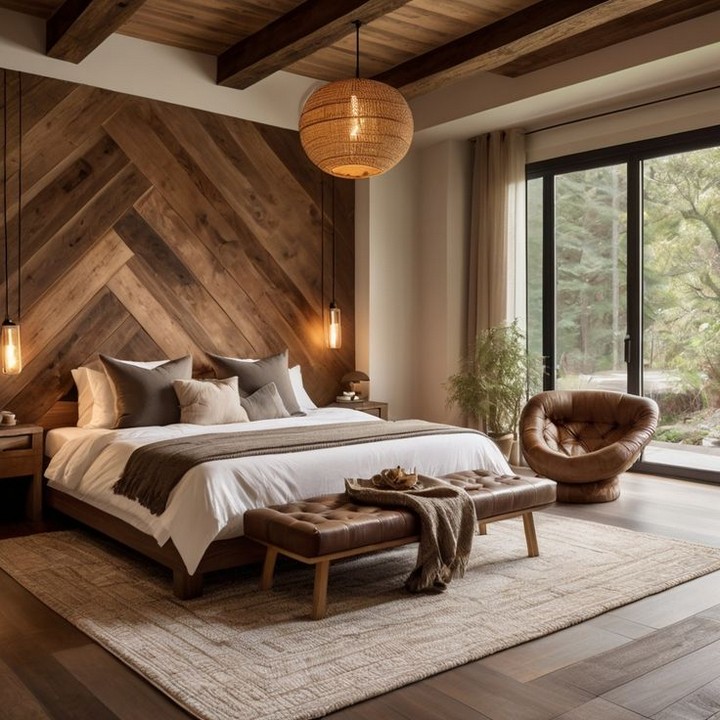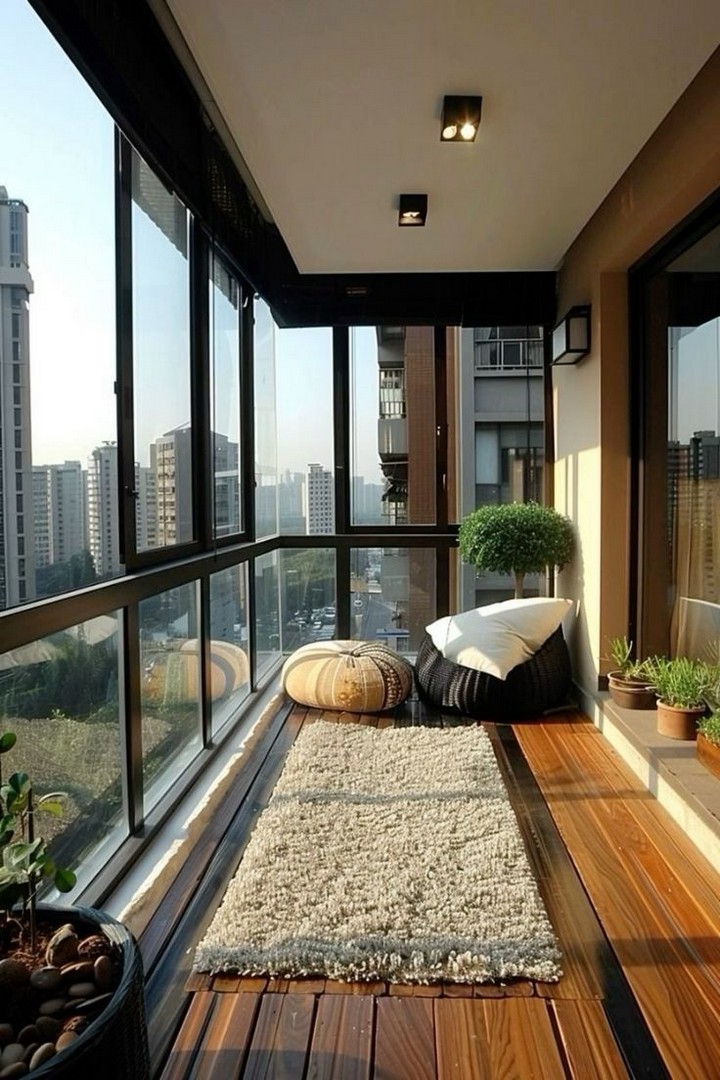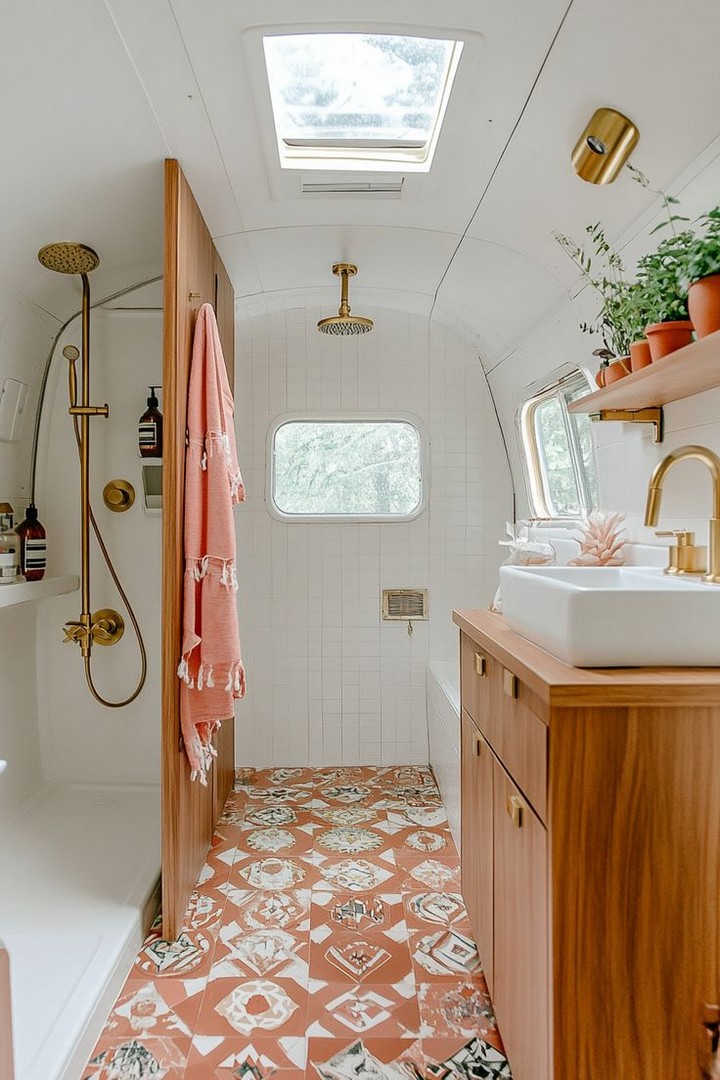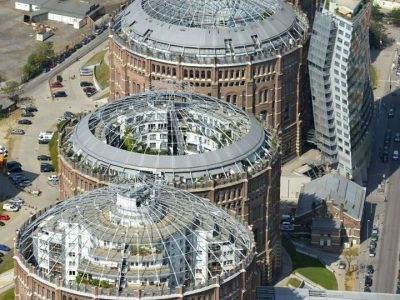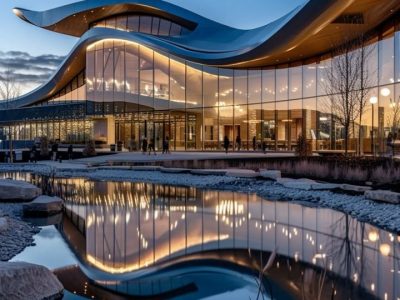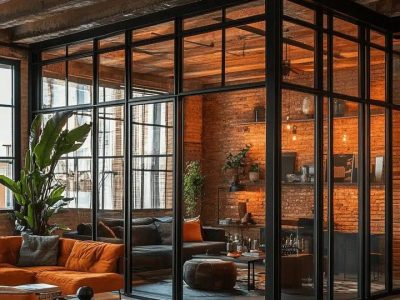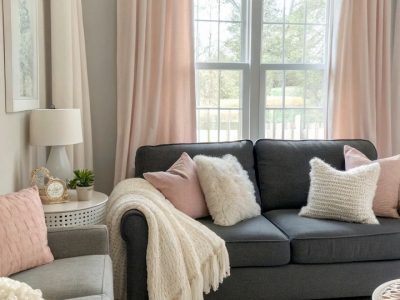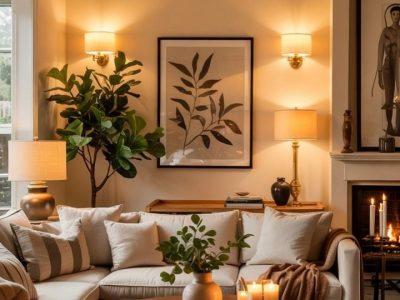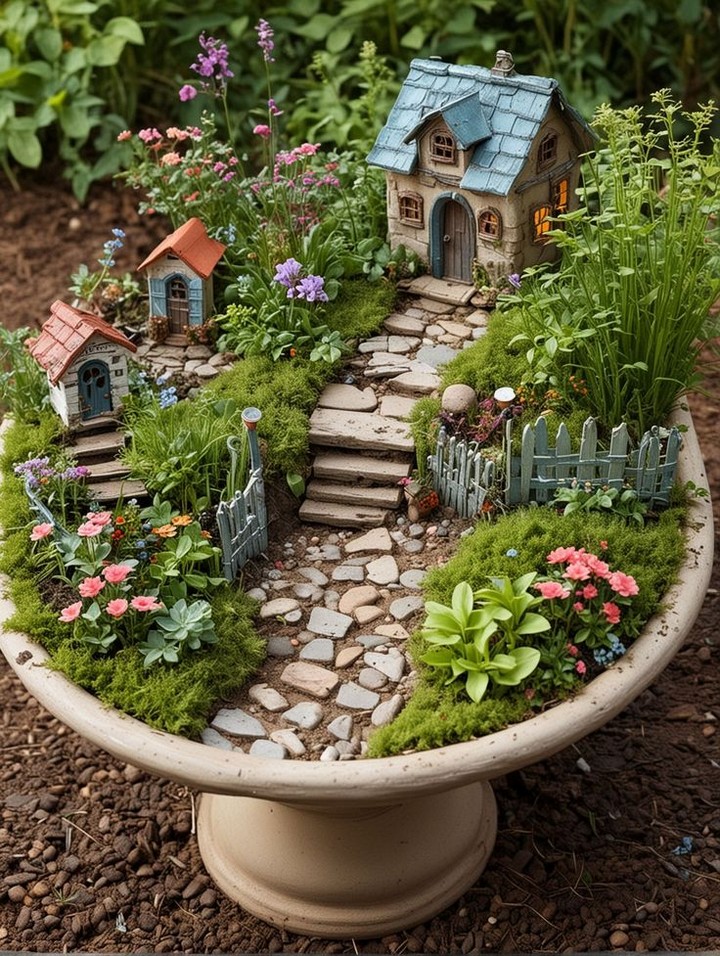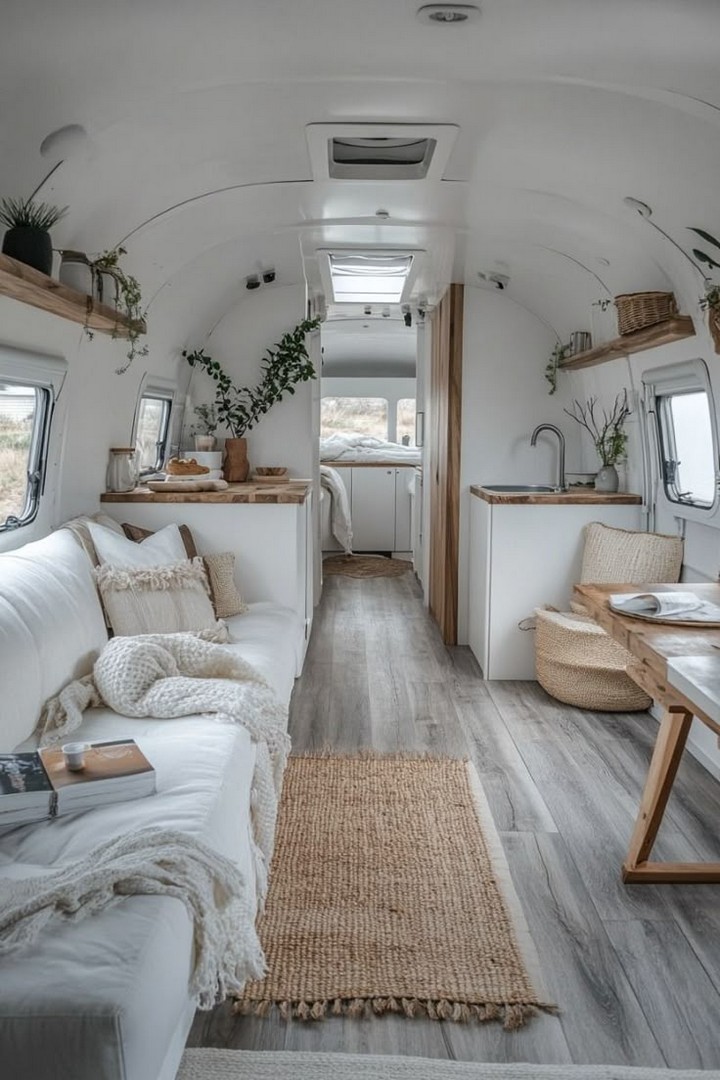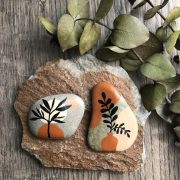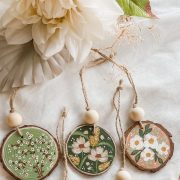The harmonious blend of rustic charm and modern minimalism embodied in Scandinavian-style homes has captivated design enthusiasts worldwide. This distinctive aesthetic marries the warmth of traditional craftsmanship with clean contemporary lines, creating spaces that feel both timeless and current. For those drawn to this balanced approach to home design, understanding the key elements that define rustic modern Scandinavian houses can provide valuable inspiration for your own living space.
In this comprehensive guide, we’ll explore 34 defining characteristics of rustic modern Scandinavian homes, from architectural features to interior design elements that create these serene, functional, and beautiful spaces.
1. Natural Setting Integration
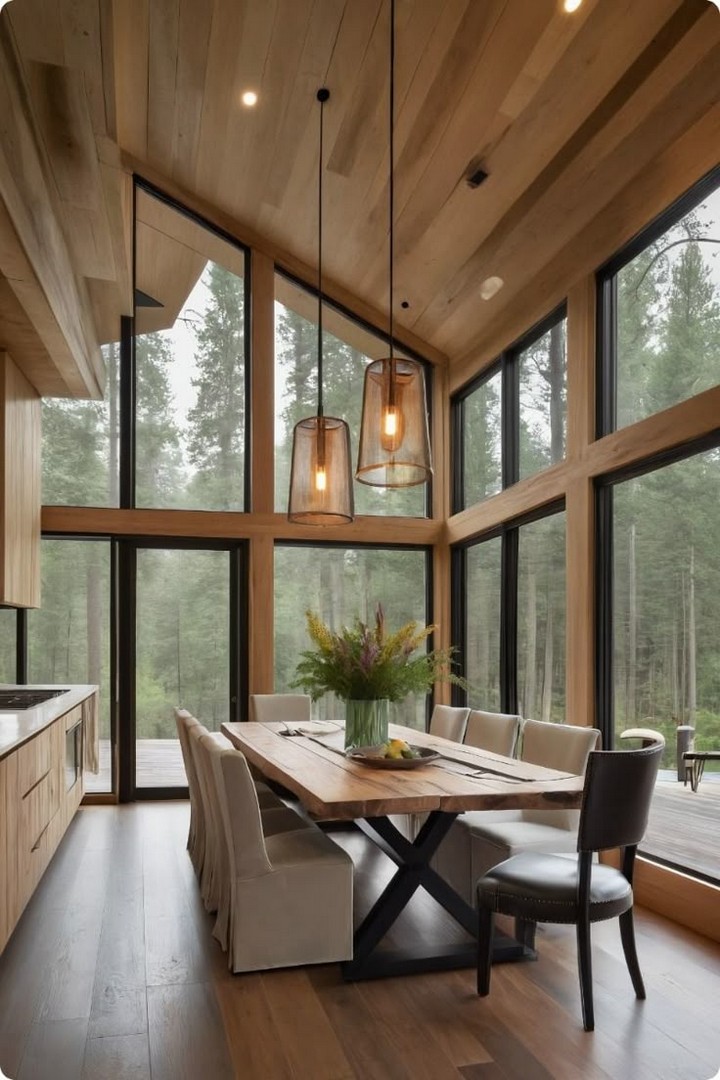
Rustic modern Scandinavian houses are designed to exist in harmony with their surroundings rather than dominate them. Large windows strategically frame forest views, lake vistas, or mountain landscapes, blurring the boundary between indoor and outdoor living. This connection to nature is fundamental to the Scandinavian lifestyle, where the harsh climate makes appreciating natural beauty essential to wellbeing.
2. Simple Geometric Forms
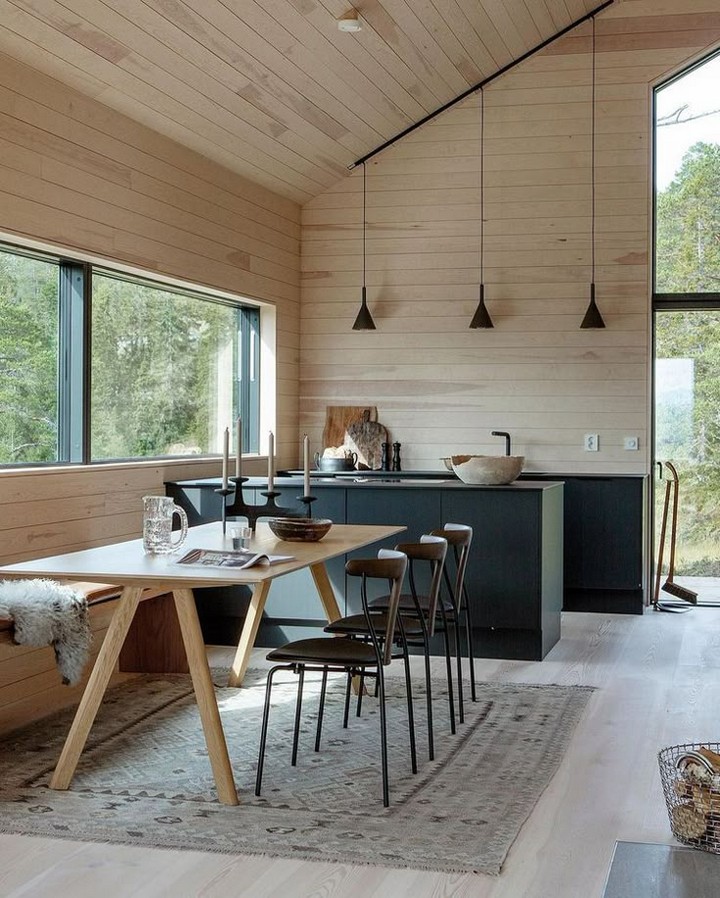
The overall structure typically features clean, uncomplicated lines and geometric shapes. Gabled roofs with pronounced angles pay homage to traditional Nordic building techniques while creating distinctive silhouettes against natural backdrops. These straightforward forms are both practical—shedding snow efficiently in northern climates—and aesthetically pleasing in their honest simplicity.
3. Mixed Material Exteriors
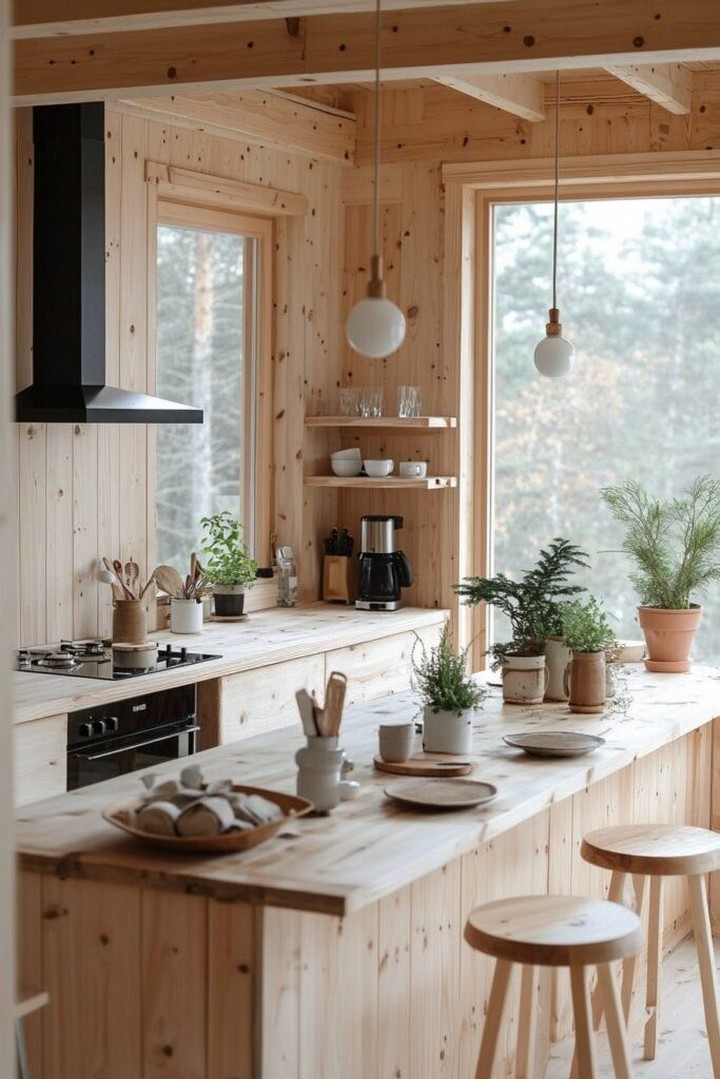
The exterior often combines natural materials in a thoughtful composition. Vertical wood cladding (often in dark stains or natural weathered finishes) might be paired with sections of exposed concrete, natural stone, or black metal accents. This material contrast creates visual interest while remaining cohesive through a limited color palette.
4. Substantial Roof Overhangs
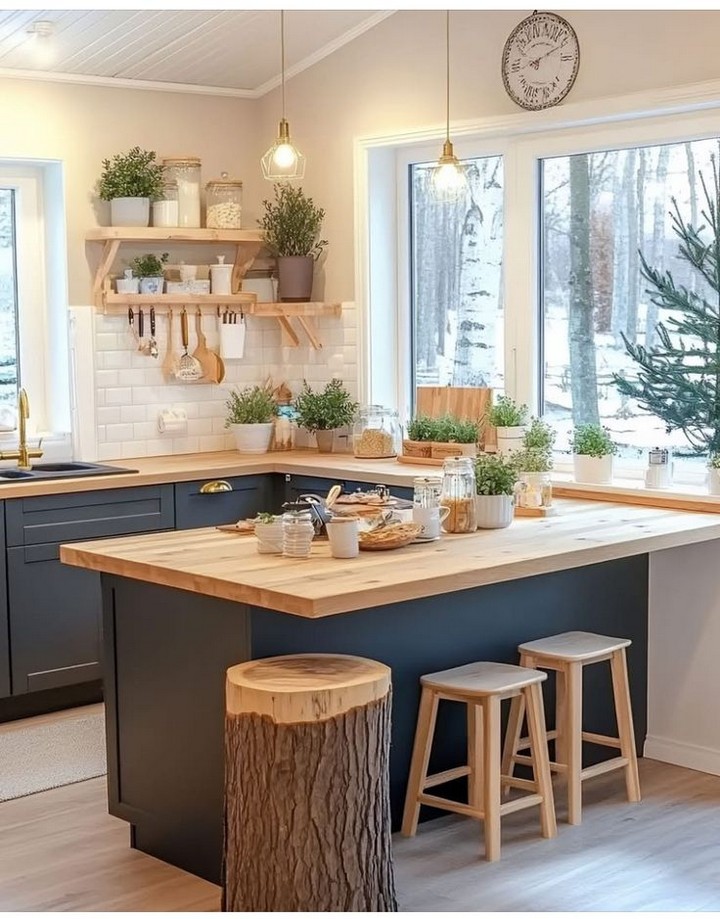
Practical yet visually striking roof overhangs protect the building from harsh weather while creating covered outdoor spaces that extend living areas. These architectural elements cast interesting shadows that change throughout the day, adding dynamic visual interest to the exterior.
5. Minimal Ornamentation

True to both rustic and modern sensibilities, these homes avoid decorative flourishes in favor of allowing materials and craftsmanship to speak for themselves. Beauty emerges from proportion, texture, and thoughtful detail rather than applied decoration.
6. Indoor-Outdoor Transitions
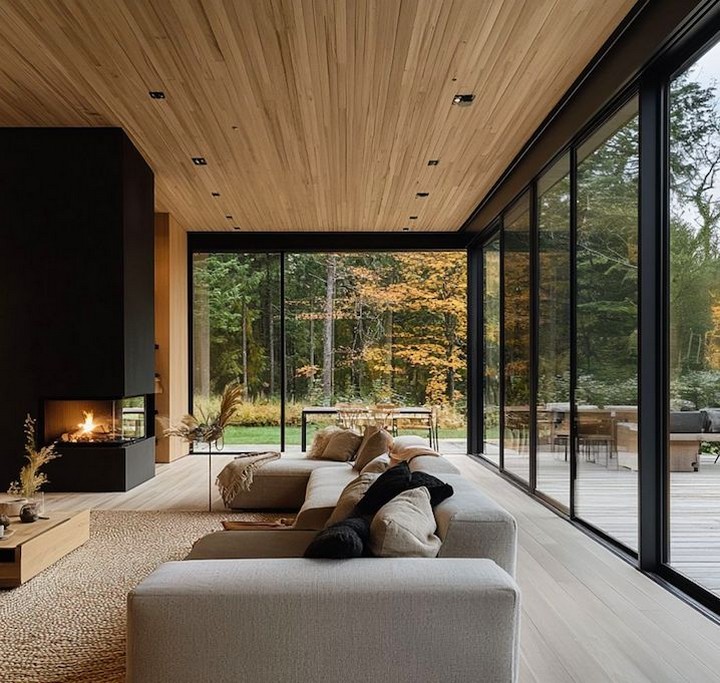
Covered porches, glass-enclosed sunrooms, and seamless thresholds between interior and exterior spaces create gradual transitions that maximize connection to nature while providing protection from the elements. These buffer zones are particularly important in Scandinavian design, where the harsh climate makes intermediate spaces valuable.
7. Asymmetrical Balance
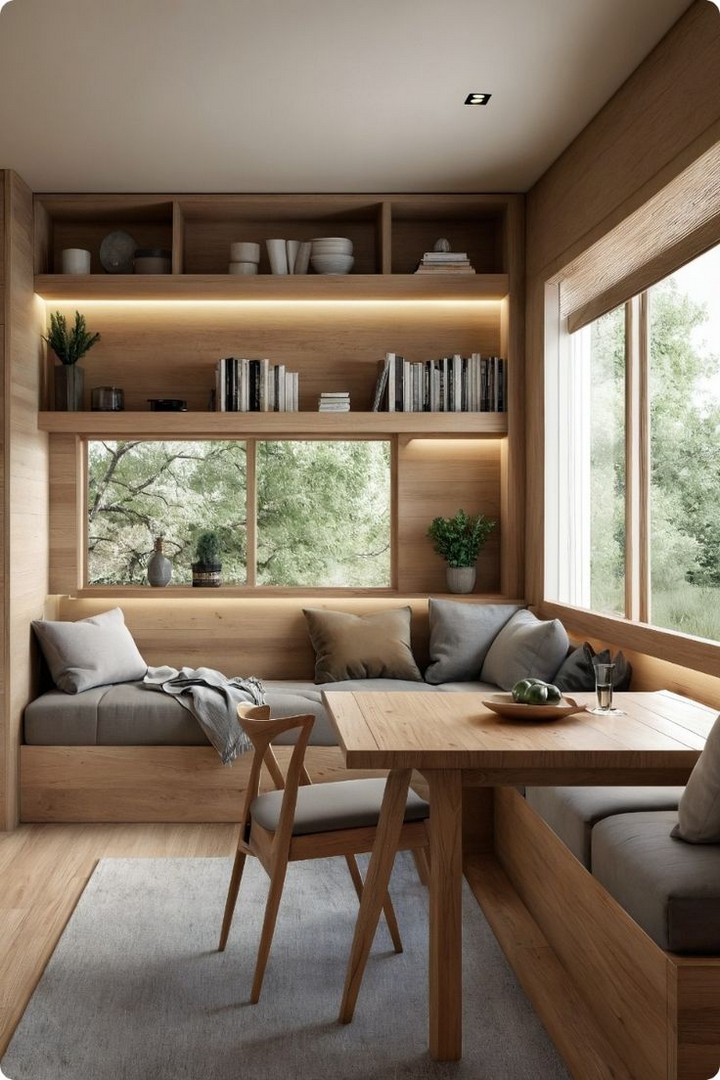
While maintaining clean lines, these homes often feature asymmetrical compositions that create visual interest without feeling chaotic. A tall, narrow section might balance against a lower, wider wing, creating a dynamic yet harmonious overall form.
Interior Structural Elements
8. Exposed Wooden Beams

One of the most iconic features of rustic modern Scandinavian interiors is exposed wooden structural elements. Whether weathered antique timbers or new wood with a natural finish, these beams add warmth, character, and a connection to traditional building methods while defining the space architecturally.
9. Vaulted Ceilings
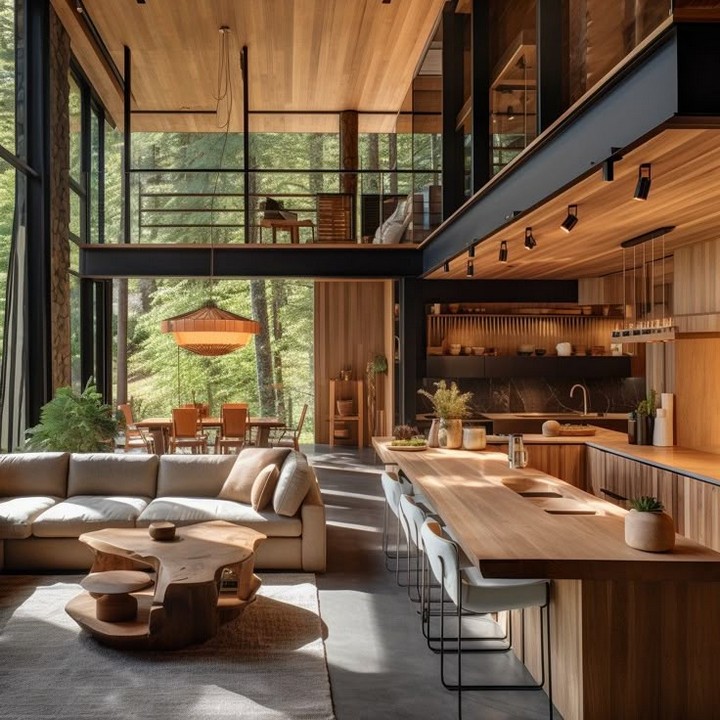
High, open ceilings with exposed structural elements create airy, light-filled spaces. These generous volumes contrast beautifully with more intimate areas of the home, creating a rhythm of expansion and contraction that makes the space feel dynamic yet comfortable.
10. Interior Glass Divisions
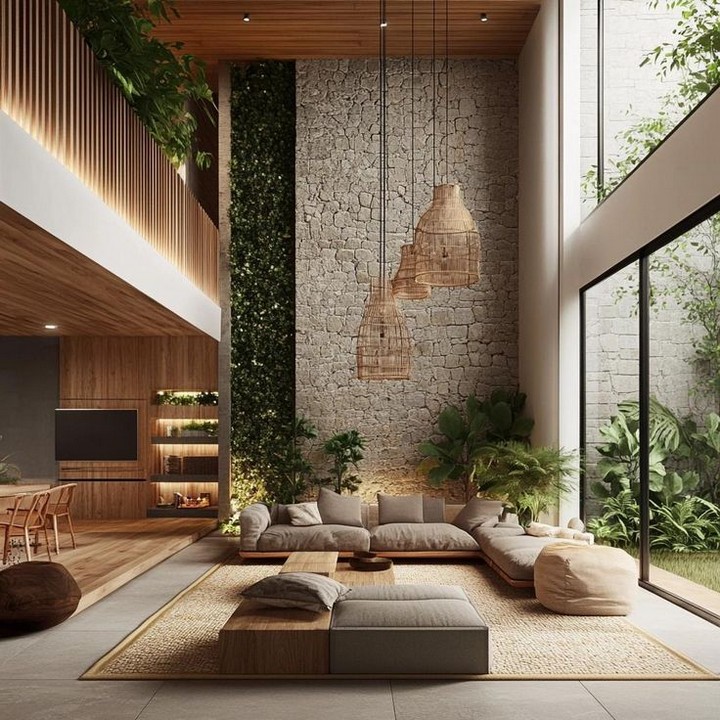
Rather than solid walls separating spaces, strategic use of glass partitions or interior windows maintains the flow of natural light while providing acoustic and functional separation. This approach preserves sightlines and spatial continuity while allowing distinct zones for different activities.
11. Tactile Material Contrasts
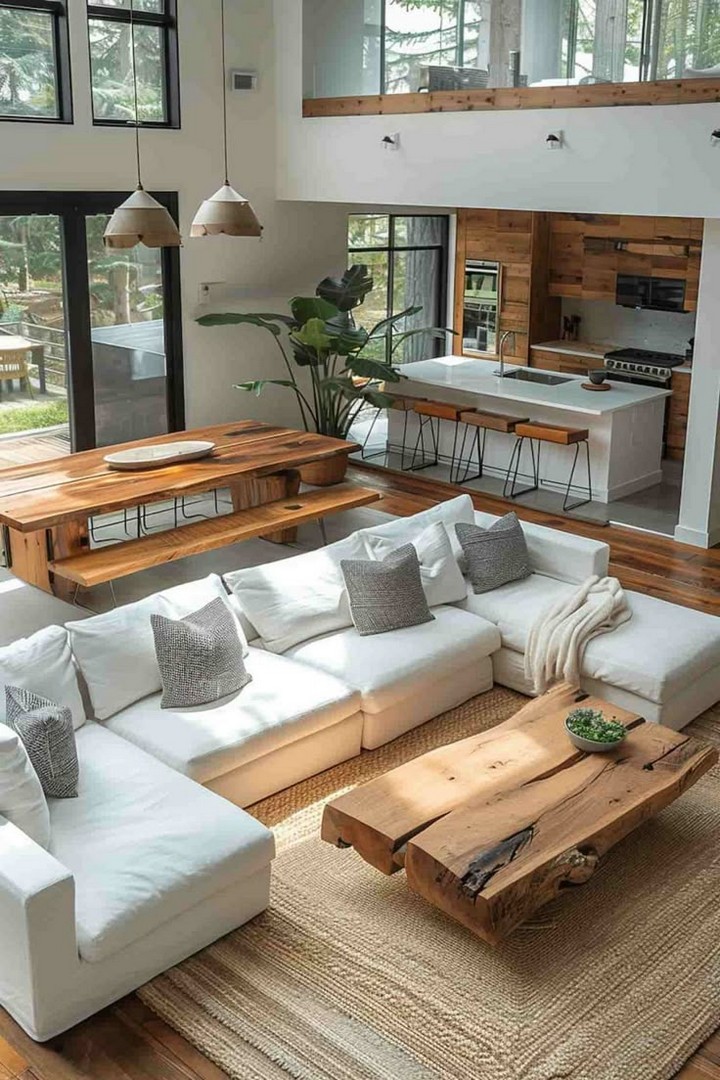
The interplay of smooth and rough textures creates subtle yet powerful sensory experiences throughout these homes. Polished concrete floors might meet rough-hewn wooden furniture, or sleek modern kitchen cabinets might be paired with a rugged stone backsplash, creating a dialogue between refined and rustic elements.
12. Minimal Interior Walls
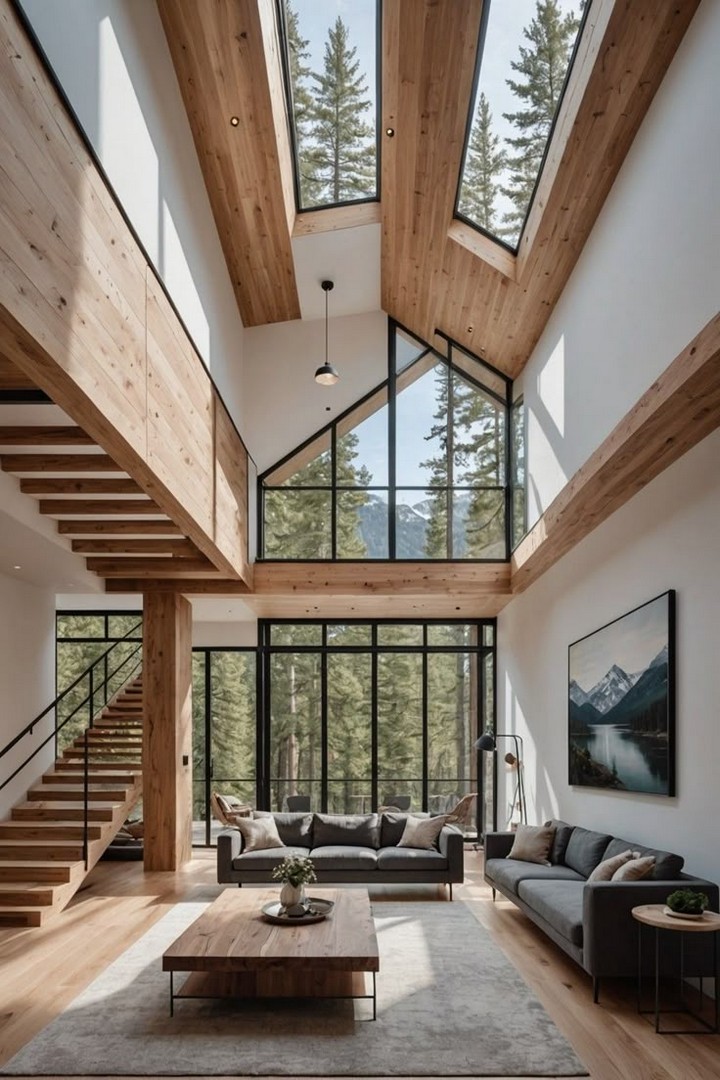
Open floor plans with thoughtful spatial definition through furniture arrangement, level changes, or material transitions create flexible, light-filled interiors. This approach maximizes natural light penetration while fostering the social connection valued in Scandinavian culture.
13. Statement Staircases

Stairs are treated as sculptural elements rather than merely functional transitions between levels. Whether featuring floating treads, integrated storage, or dramatic materials, staircases often serve as architectural focal points that embody the marriage of form and function central to this design approach.
Light and Color Strategy
14. White Base Palette
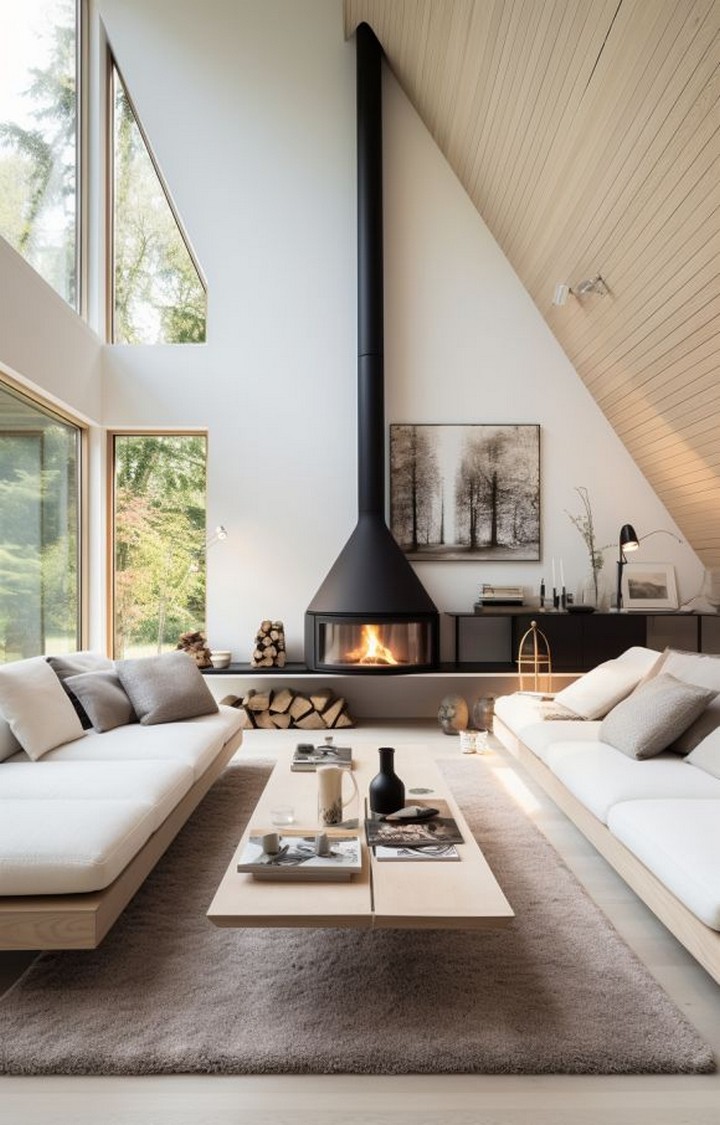
Crisp white walls serve as the foundational canvas in rustic modern Scandinavian interiors, maximizing light reflection during long, dark northern winters. This bright backdrop allows natural materials and carefully selected furnishings to stand out while creating a sense of spaciousness and clarity.
15. Strategic Natural Light Capture
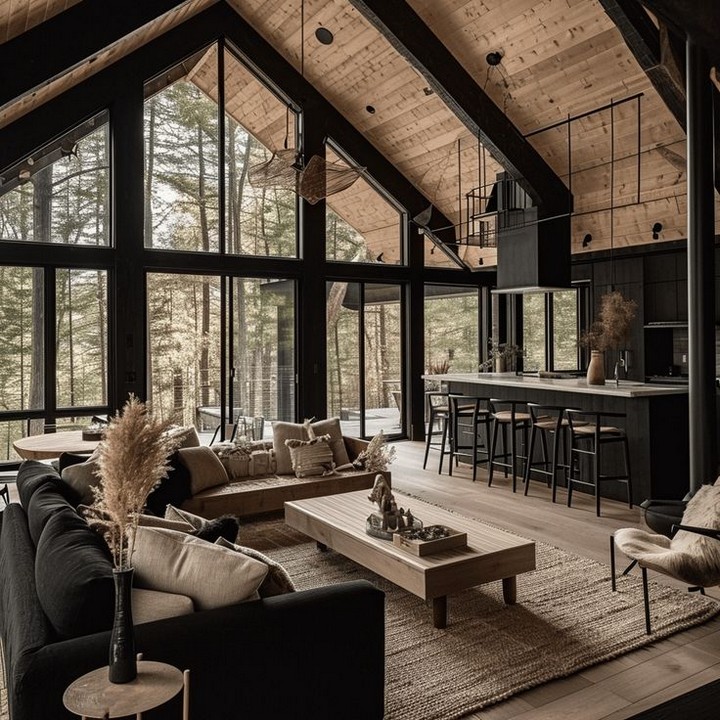
Window placement is carefully calculated to track the sun’s movement throughout the day, capturing precious natural light, particularly in northern latitudes where daylight is limited during winter months. Transom windows, skylights, and clerestory openings bring light deep into the home’s interior.
16. Layered Neutral Colors
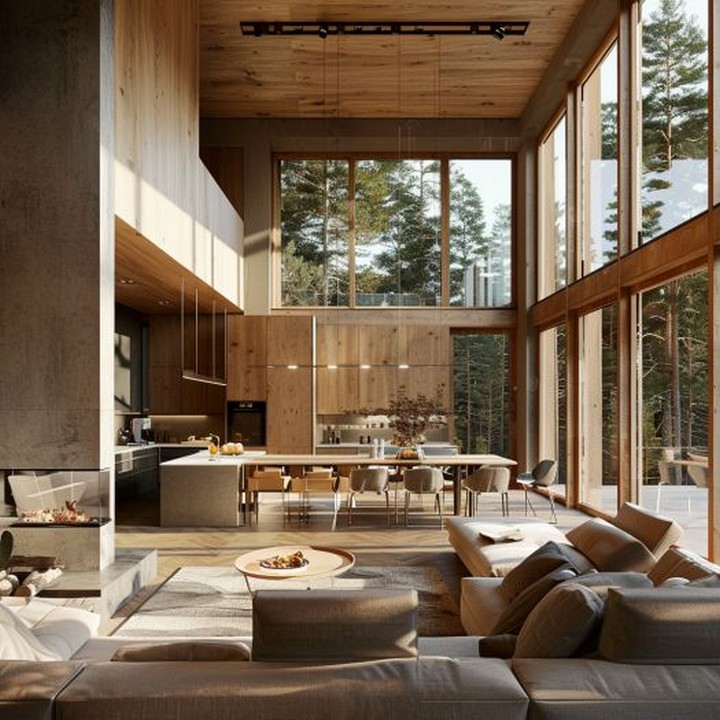
Beyond white, the color palette typically incorporates a sophisticated range of neutrals soft grays, taupes, charcoals, and black creating depth without overwhelming the serene atmosphere. These muted tones draw inspiration from the Scandinavian landscape of rocks, birch trees, and winter skies.
17. Warm Lighting Design
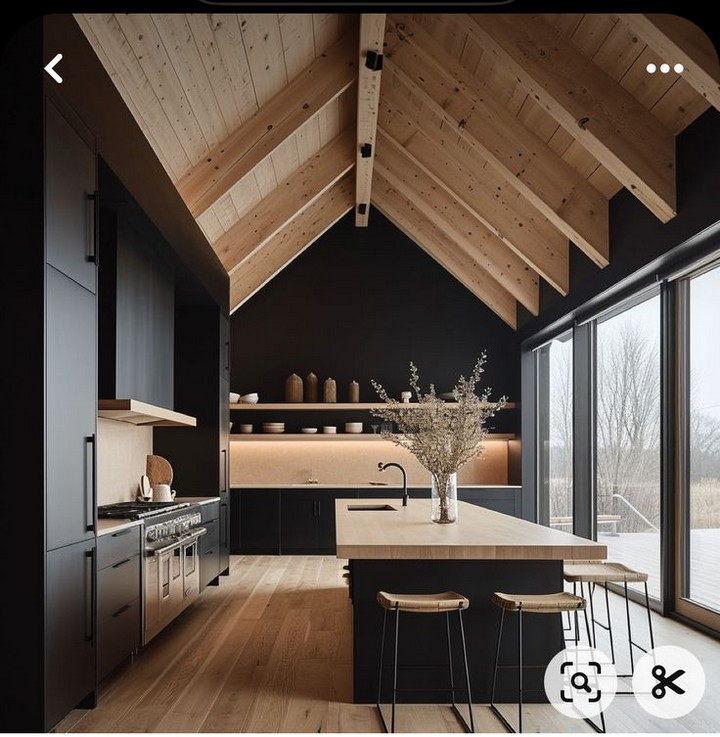
Thoughtful lighting design creates pools of warm illumination rather than uniform brightness, establishing a cozy atmosphere that counterbalances the clean architectural lines. Pendant lights, wall sconces, and floor lamps are selected as much for their sculptural qualities as their light output.
18. Selective Color Accents
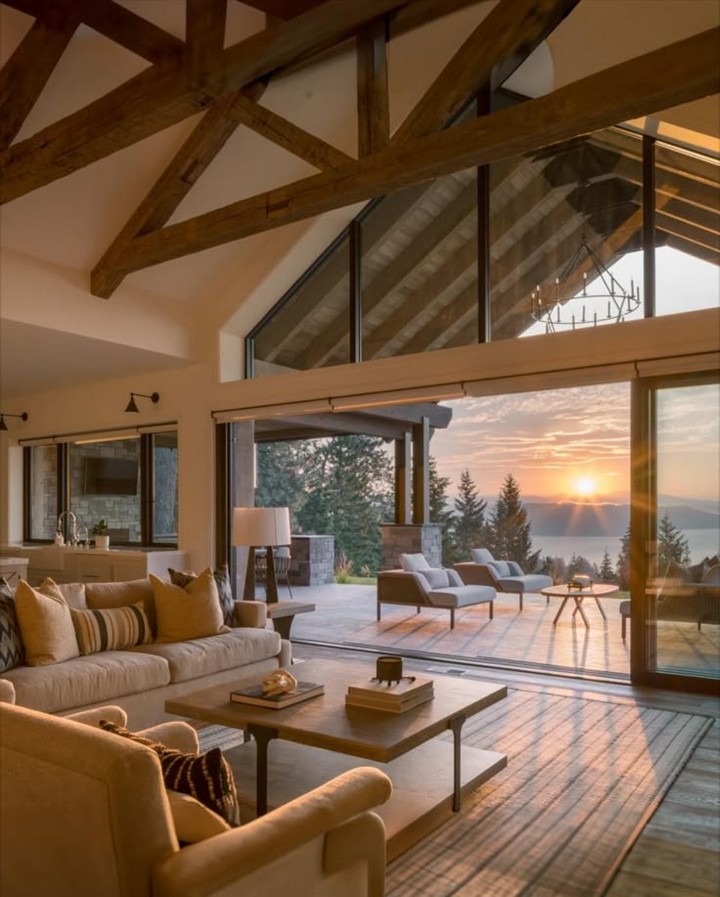
While neutrals dominate, strategic color accents often inspired by nature—add vitality to the space. Muted blues reminiscent of Nordic waters, forest greens, or berry tones might appear in textiles or smaller furnishings, creating focal points without disrupting the overall serenity.
Material Selection
19. Unfinished or Lightly Finished Woods

Wood in rustic modern Scandinavian homes typically appears in its most honest form often lightly whitewashed pine, natural ash, or oak with clear finishes that highlight rather than mask the grain. These treatments allow the material’s natural beauty to contribute to the home’s character.
20. Natural Stone Elements

Slate, limestone, or local stone varieties appear in fireplaces, accent walls, or flooring, introducing organic texture and grounding the space. These elements connect the home to the earth and provide thermal mass that moderates temperature fluctuations.
21. Black Metal Accents
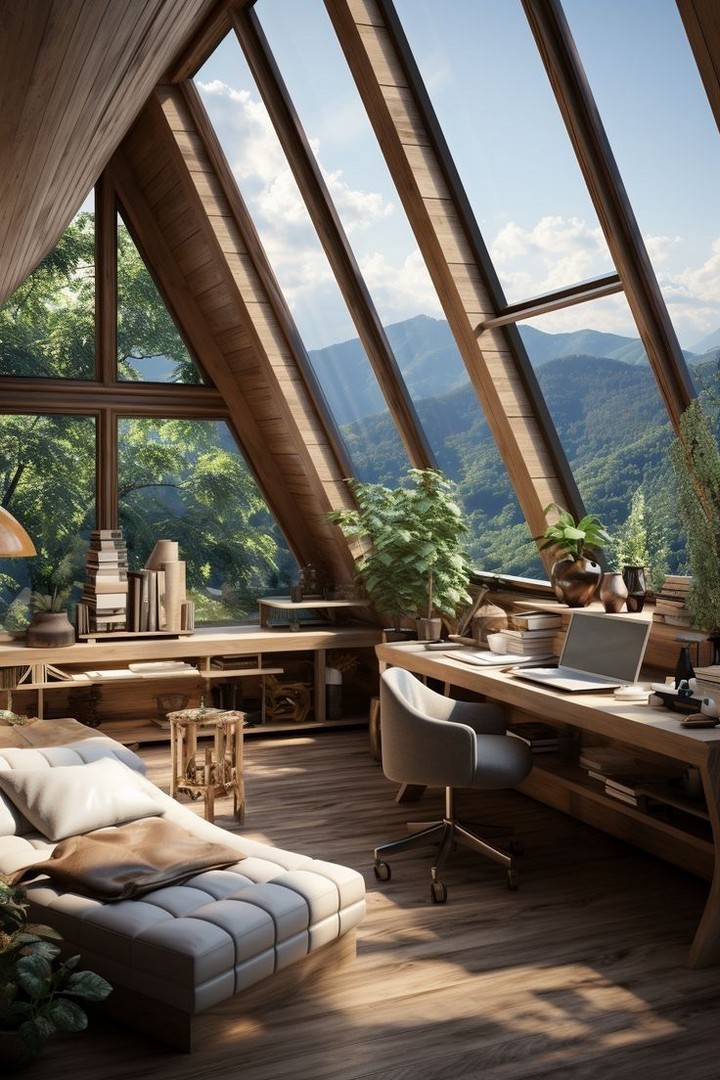
Wrought iron or blackened steel appears in lighting fixtures, hardware, and architectural details, adding graphic punch and visual weight to balance the lighter elements. These dark accents create definition and contrast in the predominantly light interiors.
22. Handcrafted Textile Integration
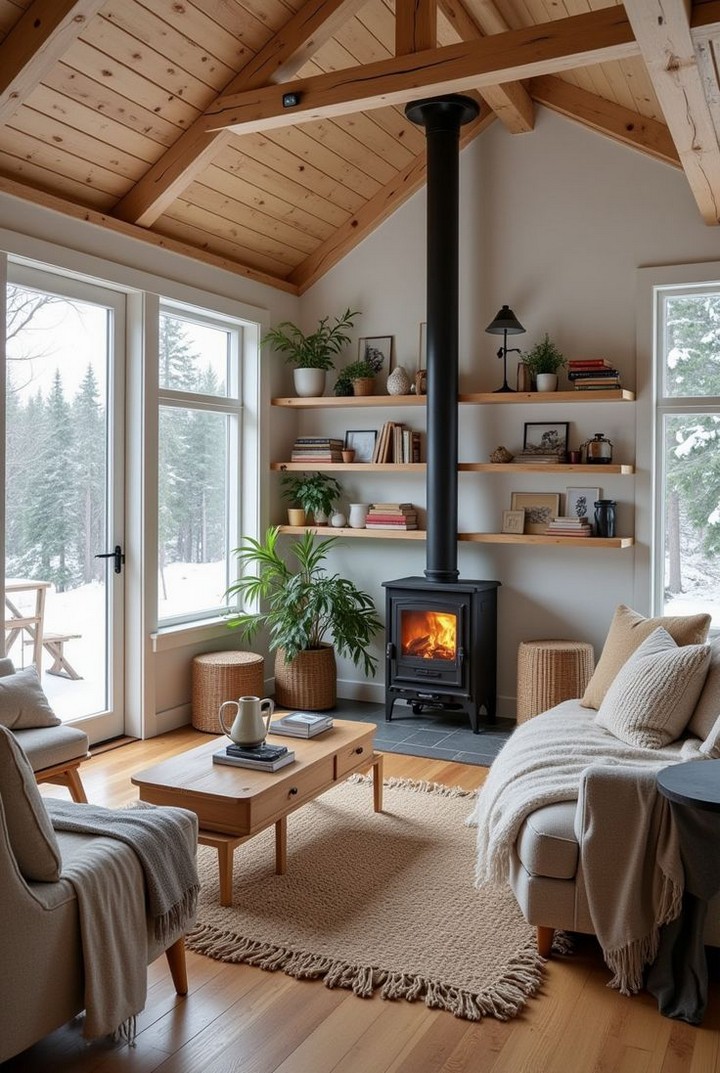
Hand-woven textiles with subtle patterns or natural textures add warmth and acoustic comfort while connecting to Nordic craft traditions. Wool, linen, and sheepskin appear in rugs, throws, and upholstery, introducing softness that counterbalances the harder architectural elements.
23. Concrete Surfaces
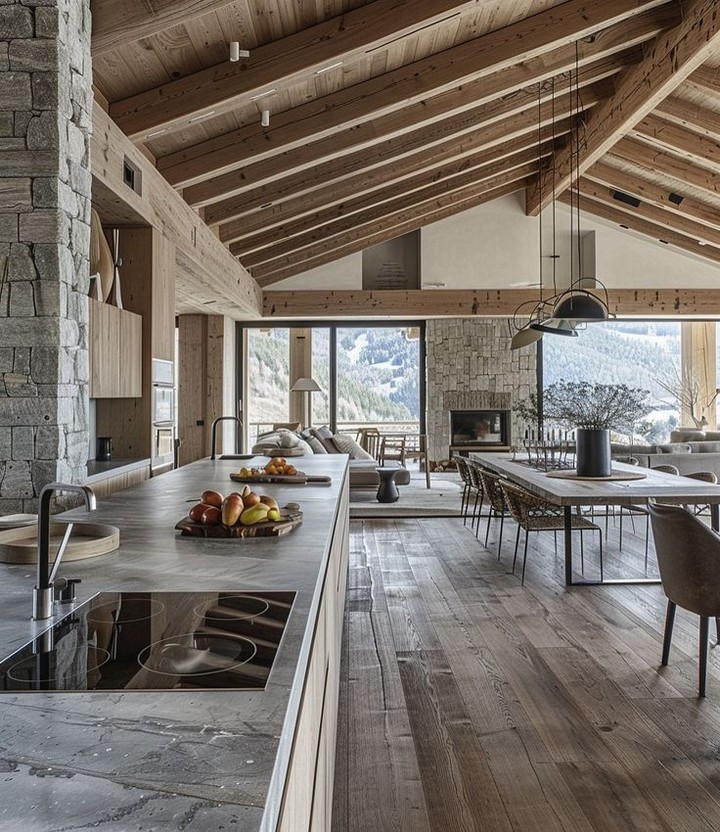
Polished or board-formed concrete brings contemporary industrial character while providing practical, durable surfaces. Often used for flooring, countertops, or architectural elements, concrete’s neutral tone and subtle variations complement wooden elements beautifully.
Furniture and Functional Elements
24. Wood-Burning Fireplace
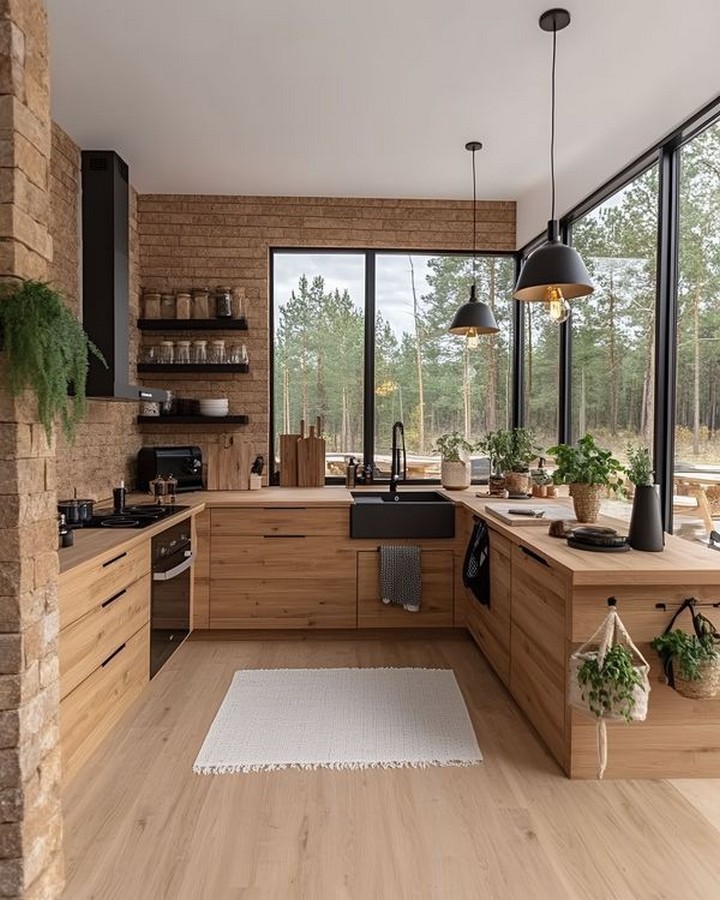
A central hearth often featuring a minimalist wood-burning stove rather than a traditional fireplace serves as both a functional heating element and a gathering point. The visual focus of dancing flames against clean design creates the quintessential Scandinavian concept of “hygge” or cozy contentment.
25. Built-In Furniture
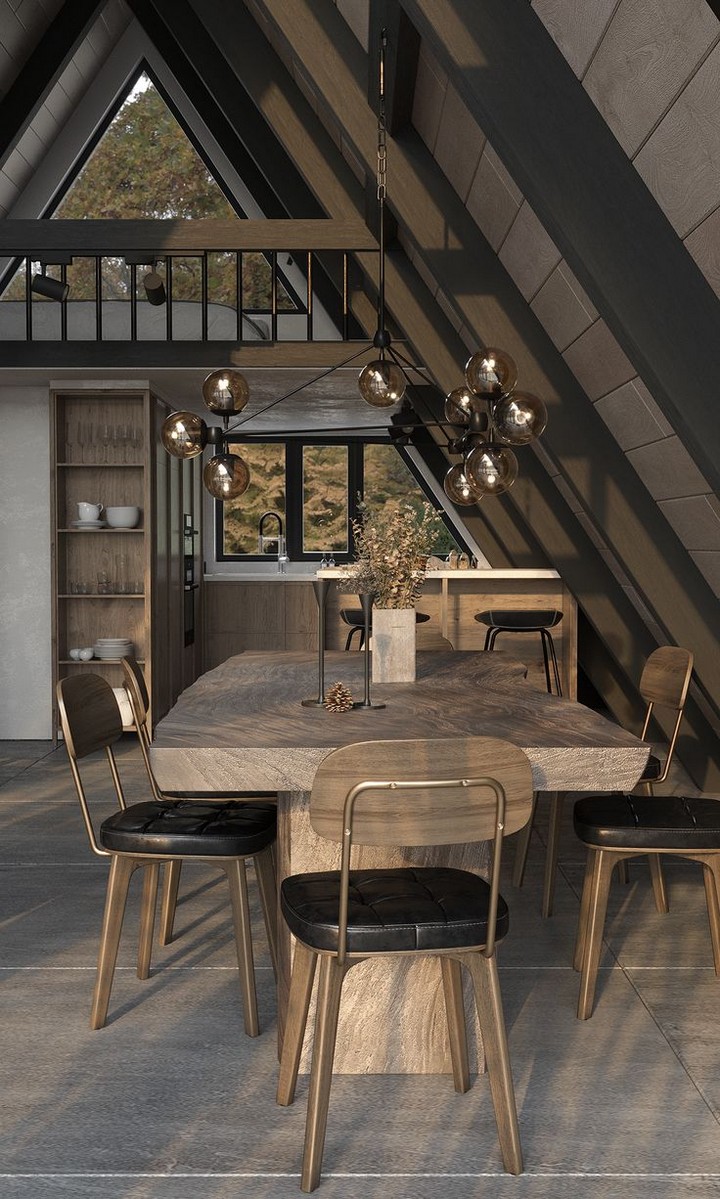
Space-efficient built-ins window seats, dining nooks, or storage walls maximize functionality while maintaining clean lines. These elements often serve multiple purposes, such as bench seating with hidden storage or staircases with integrated bookcases.
26. Iconic Scandinavian Furniture Pieces
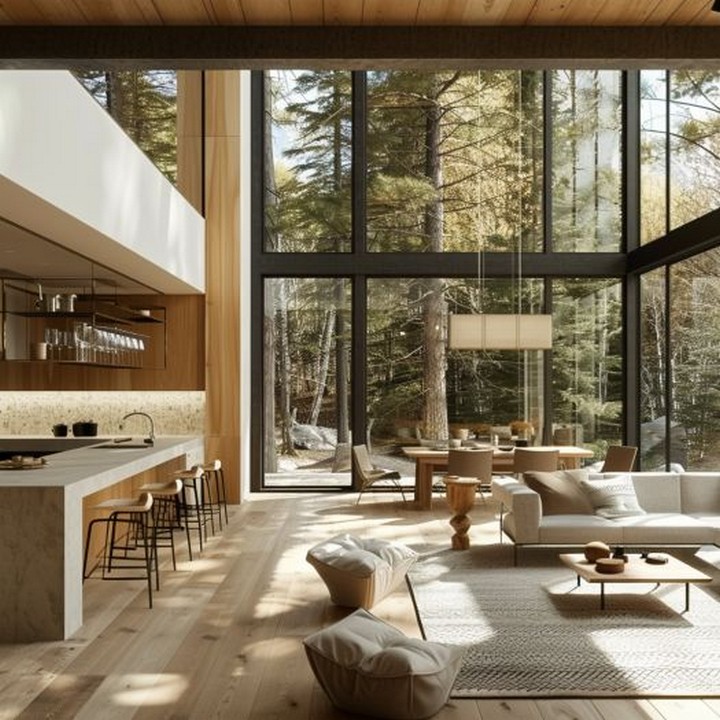
Contemporary interpretations of classic Nordic designs think Hans Wegner chairs or Alvar Aalto stools—mix with rustic elements like farmhouse tables or antique wooden chests. This blend of refined design with more humble pieces creates a collected, evolved atmosphere rather than a showroom feel.
27. Natural Material Furnishings
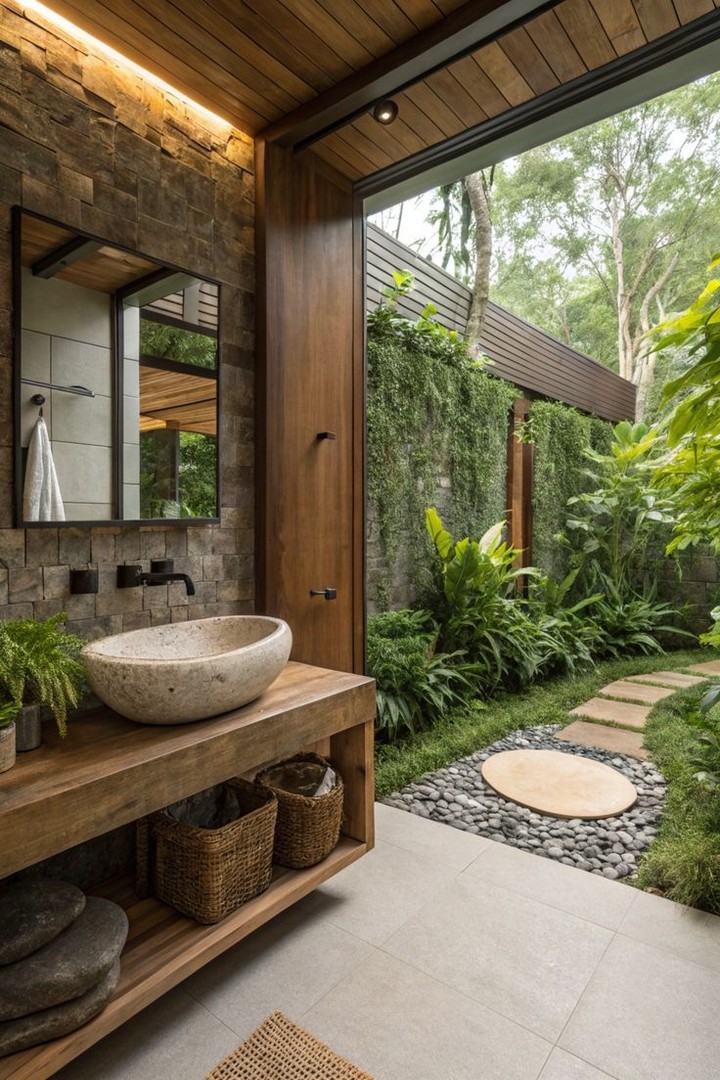
Furniture showcases natural materials with minimal processing solid wood tables with visible joinery, leather that develops patina over time, or stone tabletops with natural edge details. These authentic materials age gracefully, developing character rather than deteriorating.
28. Minimalist Kitchen Design
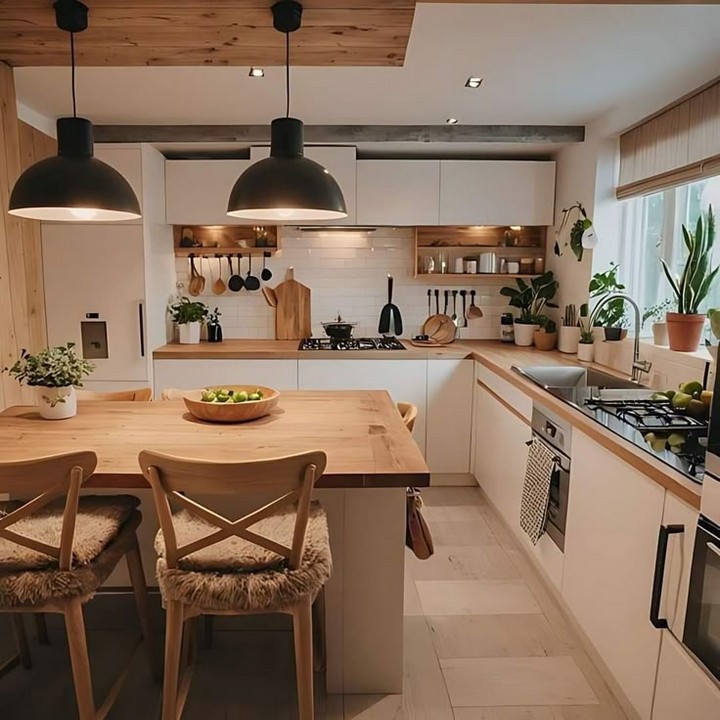
Kitchens feature clean-lined cabinetry often without visible handles paired with natural stone or wood countertops. Open shelving displaying carefully edited collections of ceramics or glassware replaces upper cabinets, maintaining the open, airy quality of the space.
Decorative Approach
29. Curated Collections
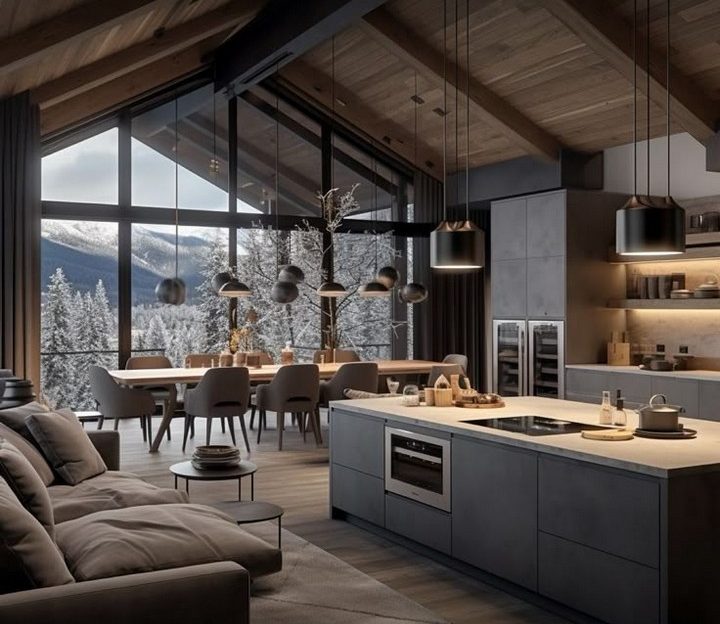
Rather than abundant decorative objects, rustic modern Scandinavian interiors feature thoughtfully selected items often natural specimens, handcrafted pottery, or objects with personal significance. These collections are displayed with breathing room, allowing each piece to be appreciated.
30. Botanical Elements
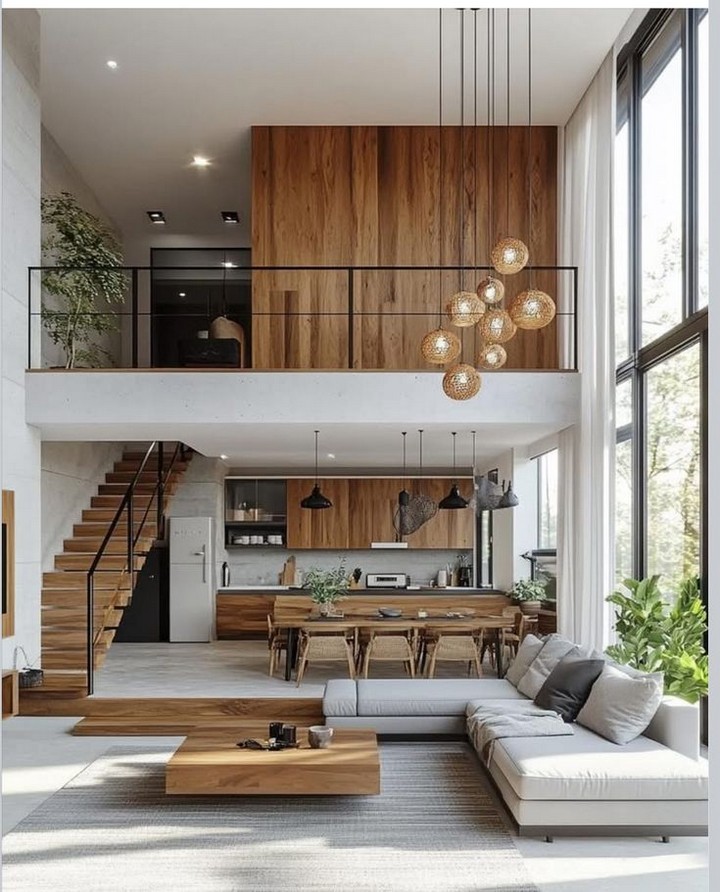
Living plants bring vitality and color to the neutral palette while improving air quality and connecting to nature. Typically displayed in simple ceramic or glass vessels, greenery adds organic shapes that soften the clean architectural lines.
31. Artisanal Ceramics
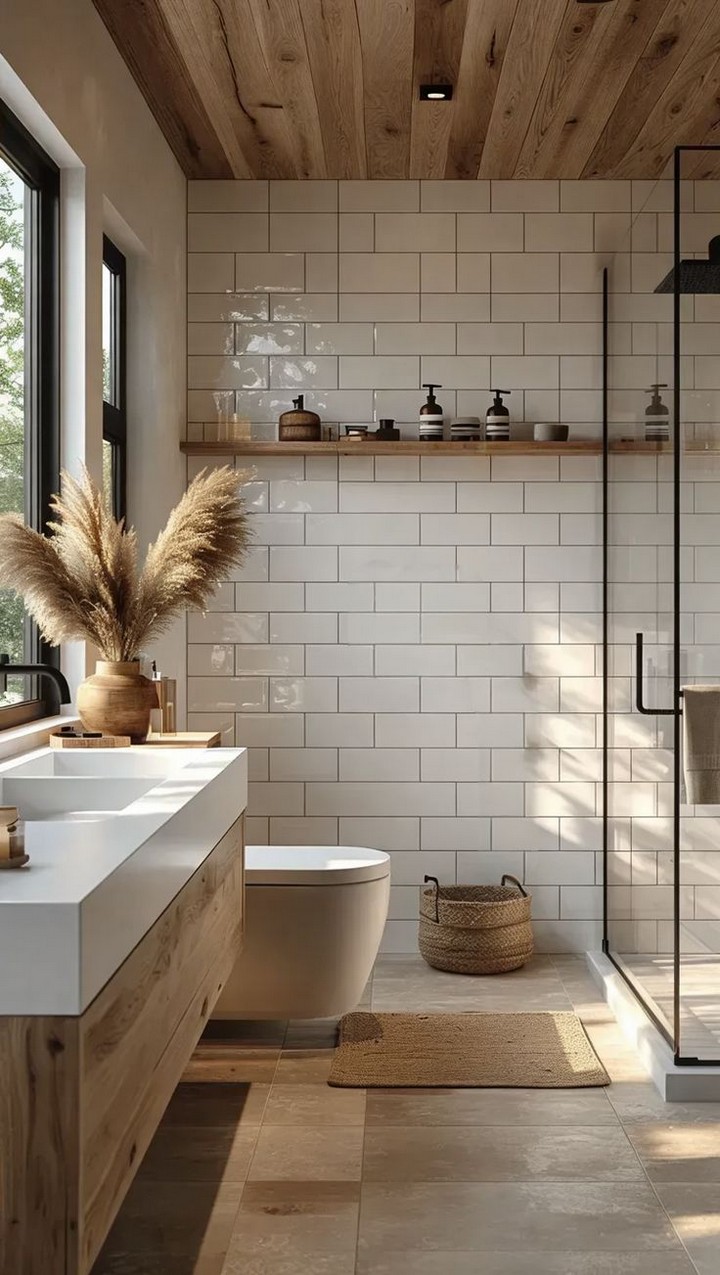
Handmade pottery in organic forms and neutral glazes adds tactile interest and personal character. These pieces often combine function and beauty a hallmark of Scandinavian design philosophy where everyday objects are elevated through thoughtful craftsmanship.
32. Graphic Black and White Art
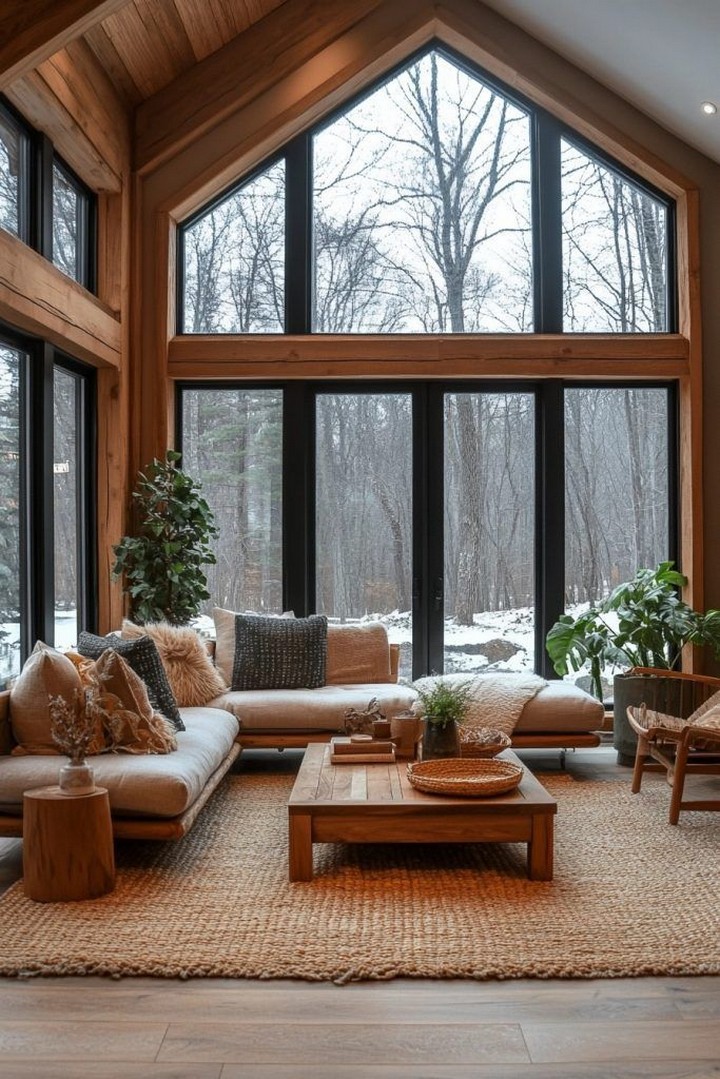
Minimalist artwork often black and white photography, simple line drawings, or abstract compositions creates focal points without competing with the architectural features. These pieces are typically displayed with museum-like simplicity, often unframed or in thin black frames.
33. Natural Object Display
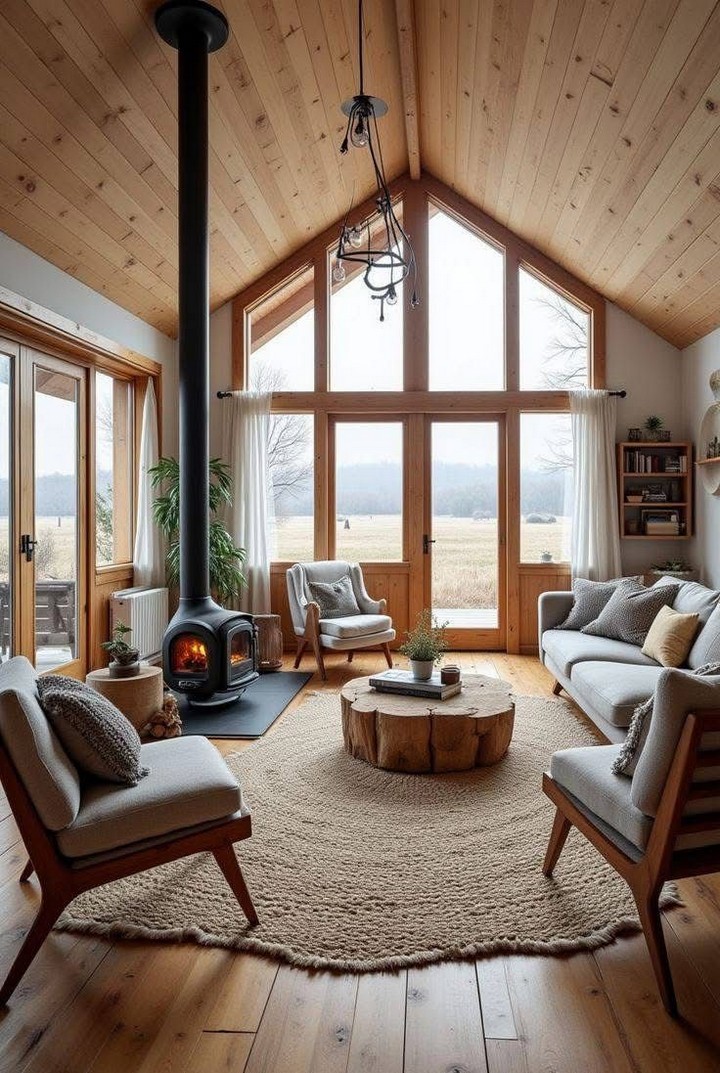
Found natural objects driftwood, stones, antlers, or botanical specimens become sculptural elements that reinforce the connection to the landscape. These organic forms introduce unpredictable shapes that contrast with the home’s geometric architecture.
34. Mindful Negative Space
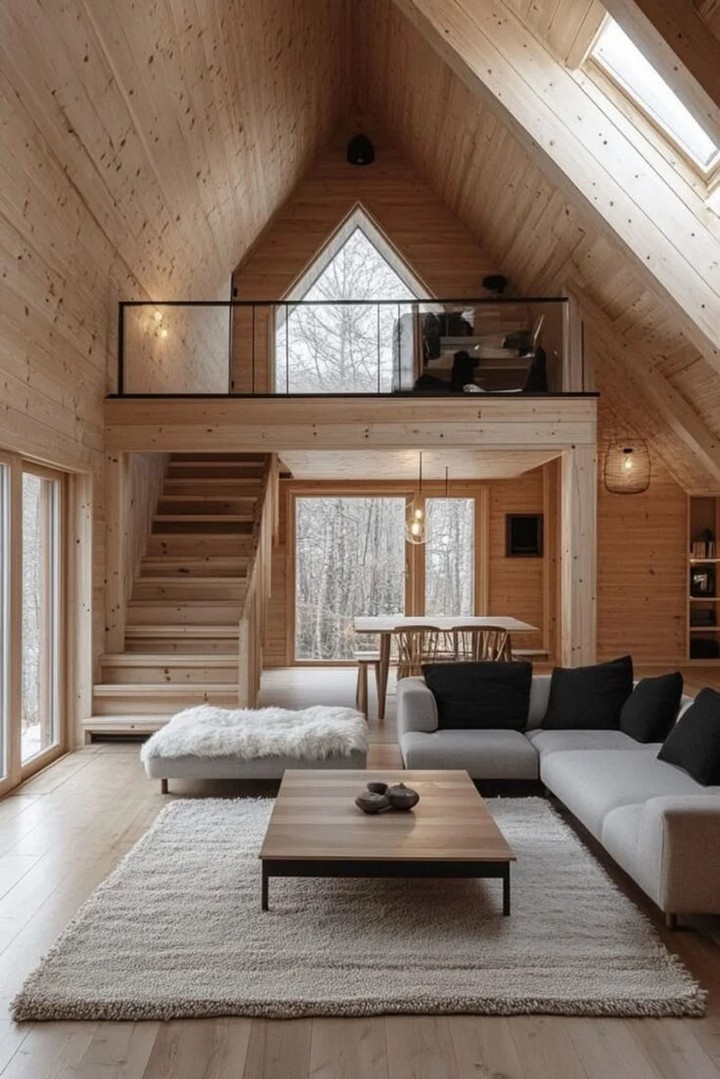
Perhaps most characteristic of rustic modern Scandinavian design is what’s not there the restrained approach to furnishing and decorating that leaves room for the eye to rest. This intentional simplicity creates calm, uncluttered environments that focus attention on quality over quantity.
Achieving Balance in Rustic Modern Scandinavian Design
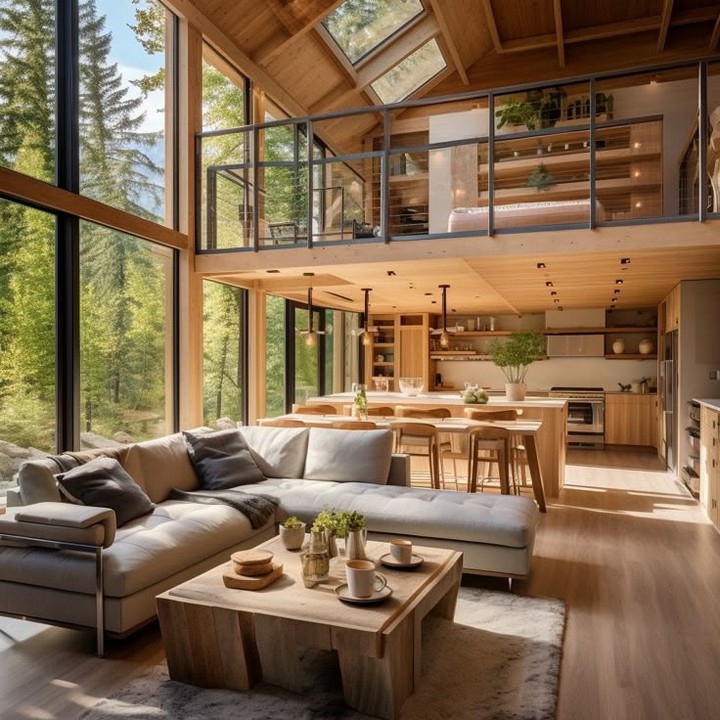
The enduring appeal of rustic modern Scandinavian homes lies in their masterful balance of seemingly contradictory elements:
- Warmth and coolness: The cool tones of white walls and concrete surfaces balanced by the warmth of wood and textiles
- Simplicity and interest: Clean lines and minimal ornamentation paired with rich natural textures
- Old and new: Traditional materials and crafts alongside contemporary design and technology
- Form and function: Beautiful spaces that never sacrifice practicality
This balance creates homes that are visually striking yet deeply comfortable, modern yet timeless, sophisticated yet unpretentious.
Sustainability in Rustic Modern Scandinavian Homes
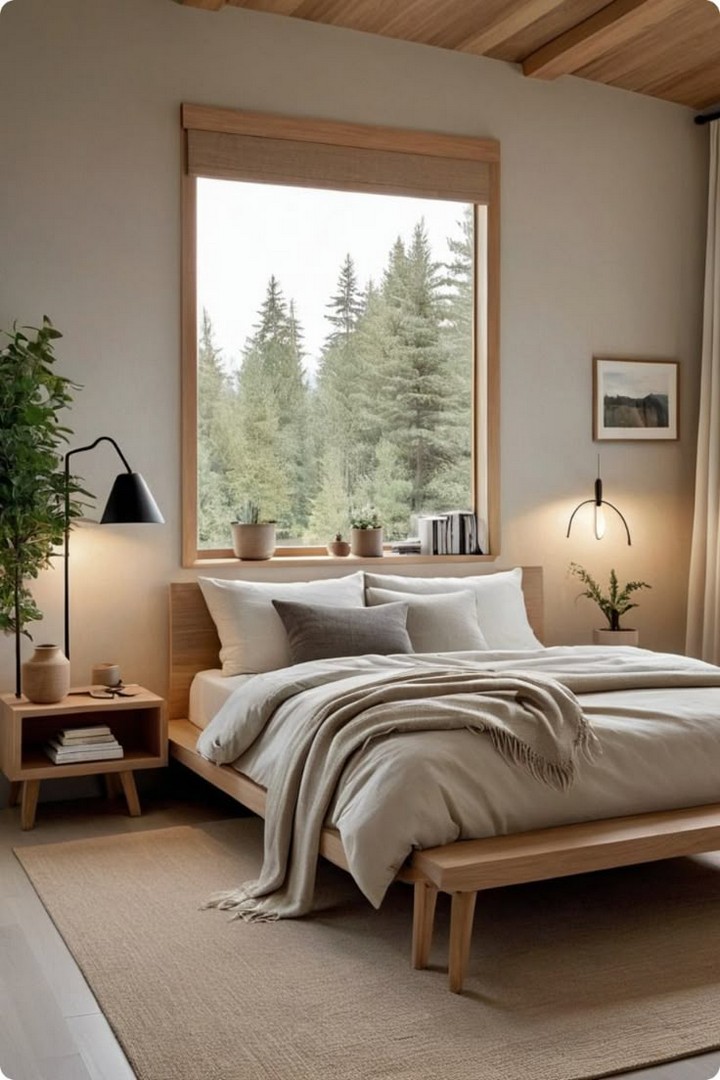
Beyond aesthetics, these homes often embody sustainable principles drawn from Scandinavian values:
- Durable, long-lasting materials that age beautifully rather than requiring replacement
- Energy-efficient design with superior insulation and strategic natural light
- Modest footprints that maximize functionality within reasonable square footage
- Connection to nature that fosters environmental appreciation and stewardship
These principles make rustic modern Scandinavian design not just a style choice but a holistic approach to living that values quality, simplicity, and harmony with the natural world.
Creating Your Own Rustic Modern Scandinavian Space
While not everyone can build a complete Scandinavian-inspired home, many elements of this style can be incorporated into existing spaces:
- Simplify your color palette, focusing on whites, neutrals, and natural materials
- Introduce wooden elements with visible grain and honest finishes
- Maximize natural light through window treatments and strategic mirror placement
- Edit possessions to display only what is beautiful, useful, or meaningful
- Incorporate textural contrasts through textiles and material selections
- Bring nature indoors with plants and organic materials
By focusing on these core principles, you can create spaces with the serene, welcoming quality that makes rustic modern Scandinavian homes so appealing.
Your Scandinavian-Inspired Spaces
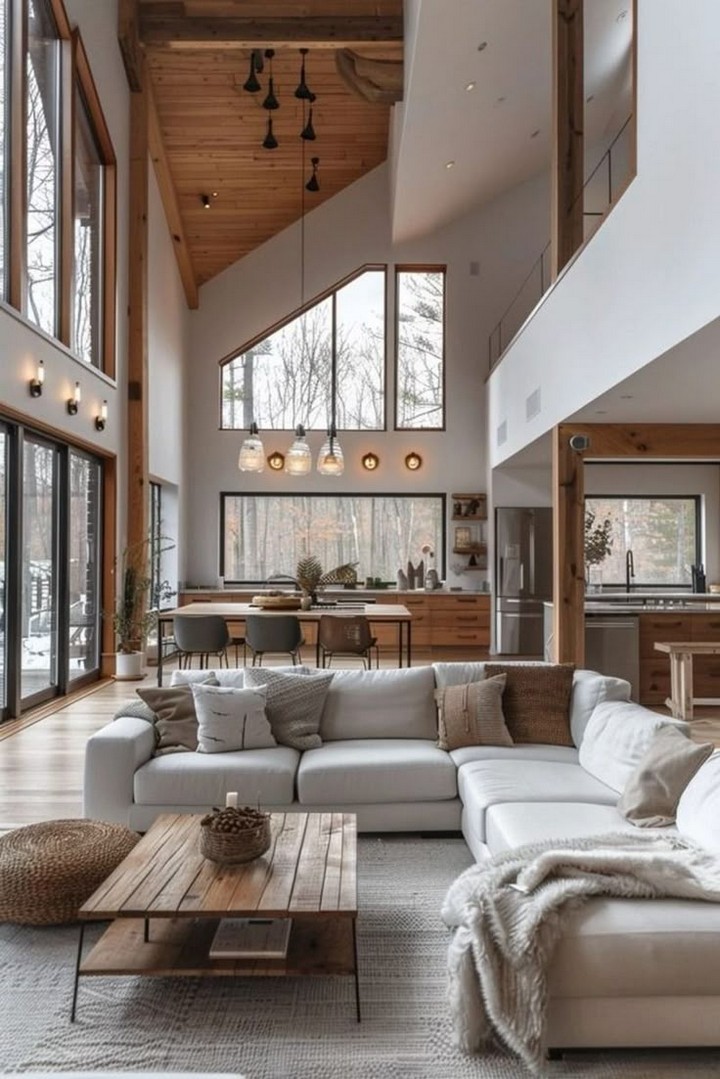
Are you inspired by the rustic modern Scandinavian aesthetic? We’d love to see how you’ve incorporated these elements into your own home. For more inspiration on creating balanced, beautiful living spaces that blend traditional craftsmanship with contemporary design, subscribe to our newsletter or follow our blog for weekly updates on thoughtful home design approaches from around the world.
What element of rustic modern Scandinavian style speaks to you most? Let us know in the comments!

